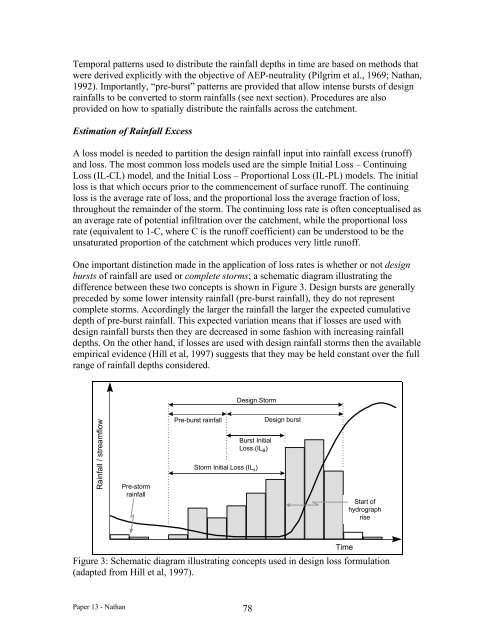Hydrologic Issues for Dams - Association of State Dam Safety Officials
Hydrologic Issues for Dams - Association of State Dam Safety Officials
Hydrologic Issues for Dams - Association of State Dam Safety Officials
Create successful ePaper yourself
Turn your PDF publications into a flip-book with our unique Google optimized e-Paper software.
Temporal patterns used to distribute the rainfall depths in time are based on methods thatwere derived explicitly with the objective <strong>of</strong> AEP-neutrality (Pilgrim et al., 1969; Nathan,1992). Importantly, “pre-burst” patterns are provided that allow intense bursts <strong>of</strong> designrainfalls to be converted to storm rainfalls (see next section). Procedures are alsoprovided on how to spatially distribute the rainfalls across the catchment.Estimation <strong>of</strong> Rainfall ExcessA loss model is needed to partition the design rainfall input into rainfall excess (run<strong>of</strong>f)and loss. The most common loss models used are the simple Initial Loss – ContinuingLoss (IL-CL) model, and the Initial Loss – Proportional Loss (IL-PL) models. The initialloss is that which occurs prior to the commencement <strong>of</strong> surface run<strong>of</strong>f. The continuingloss is the average rate <strong>of</strong> loss, and the proportional loss the average fraction <strong>of</strong> loss,throughout the remainder <strong>of</strong> the storm. The continuing loss rate is <strong>of</strong>ten conceptualised asan average rate <strong>of</strong> potential infiltration over the catchment, while the proportional lossrate (equivalent to 1-C, where C is the run<strong>of</strong>f coefficient) can be understood to be theunsaturated proportion <strong>of</strong> the catchment which produces very little run<strong>of</strong>f.One important distinction made in the application <strong>of</strong> loss rates is whether or not designbursts <strong>of</strong> rainfall are used or complete storms; a schematic diagram illustrating thedifference between these two concepts is shown in Figure 3. Design bursts are generallypreceded by some lower intensity rainfall (pre-burst rainfall), they do not representcomplete storms. Accordingly the larger the rainfall the larger the expected cumulativedepth <strong>of</strong> pre-burst rainfall. This expected variation means that if losses are used withdesign rainfall bursts then they are decreased in some fashion with increasing rainfalldepths. On the other hand, if losses are used with design rainfall storms then the availableempirical evidence (Hill et al, 1997) suggests that they may be held constant over the fullrange <strong>of</strong> rainfall depths considered.Design StormRainfall / streamflowPre-stormrainfallPre-burst rainfallBurst InitialLoss (IL B )Storm Initial Loss (IL s )Design burstStart <strong>of</strong>hydrographriseTimeFigure 3: Schematic diagram illustrating concepts used in design loss <strong>for</strong>mulation(adapted from Hill et al, 1997).Paper 13 - Nathan 78

















